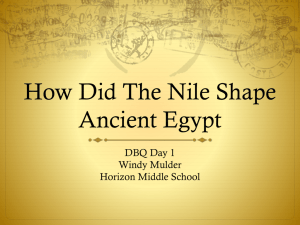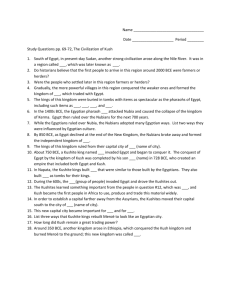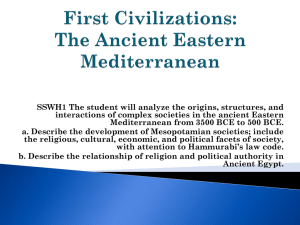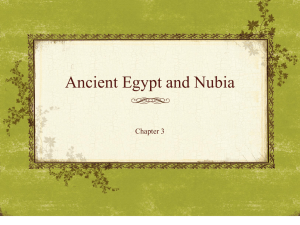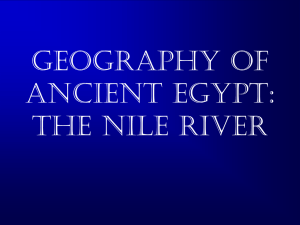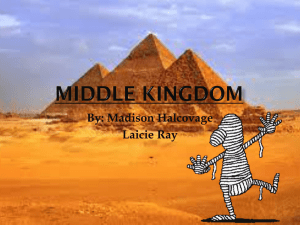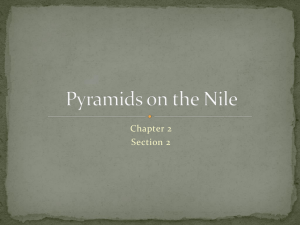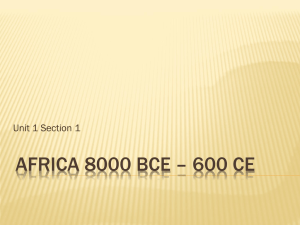Ancient Egypt
advertisement
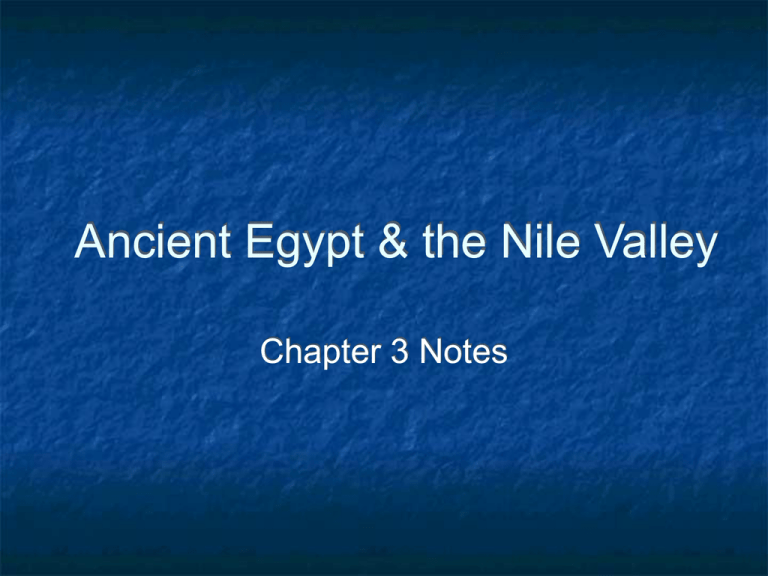
Ancient Egypt & the Nile Valley Chapter 3 Notes A River Valley & Its People One of the world’s first civilizations developed along the banks of the Nile In northeastern Africa Nile = world’s longest river People of the Nile relied on the river’s yearly floods to bring them water Green Nile Valley = stark contrast to deserts surrounding it on either side A River Valley & Its People Rich black soil in Valley = good for farming 5000 BCE = farmers began to settle down in the Valley Grew cereal crops (wheat, barley) Hunted ducks & geese; fished Early Egyptians harvested papyrus Used for rope, sandals, baskets, and paper A River Valley & Its People Early farming villages prospered --> WHY?? Because they were protected from foreign invasions by deserts and cataracts (waterfalls) in the Nile Strong leaders united the farming villages into kingdoms or monarchies ruled by a king A River Valley & Its People By 4000 BCE, Egypt had 2 large kingdoms Lower Egypt (in the north) Upper Egypt (in the south) 3000 BCE = Narmer (king of Upper Egypt) attacked Lower Egypt and united the 2 Capital = Memphis 1st of the Egyptian dynasties Egyptian dynasties divided into 3 periods: Old, Middle, New The Old Kingdom (2700 BCE to 2200 BCE) People saw their kings as gods Called a theocracy = same person is the political AND religious leader King gave many responsibilities to a bureaucracy = groups of government officials King controlled trade & taxes King supervised building of canals, dams, grain storehouses The Old Kingdom (2700 BCE to 2200 BCE) Egyptians built pyramids as burial places for their kings Great Pyramids in Giza King’s bodies were mummified for preservation Pyramids as Tombs Mummification The Middle Kingdom (2050 BCE to 1800 BCE) Old Kingdom ended with violence & a new dynasty reunited Egypt Capital moved to Thebes Theben kings = seized new territory & added thousands of acres to their civilization Built canals and irrigation systems The Middle Kingdom (2050 BCE to 1800 BCE) Local leaders began to challenge the kings’ power, which threatened peace At same time = 1st real threat to Egypt = invasion by Hyksos (people from western Asia) Hyksos swept through with new tools for war --> bronze weapons & horse-drawn chariots Easily conquered the Egyptians & set up a new dynasty (for about 110 years) The New Kingdom Egyptian prince named Ahmose raised an army & drove the Hyksos out Ahmose & those that came after him used the title pharaoh Rebuilt Egypt & conquered more land The New Kingdom 1480 BCE = Queen Hatshepsut came to power in Egypt = 1st female pharaoh After her death, her stepson Thutmose III took over Thutmose III created an army, conquered neighboring Syria, and expanded the Egyptian empire Empire = many territories under one ruler Egyptian empire grew rich & benefited from cultural diffusion The New Kingdom 1370 BCE = ruler named Amenhotep = created new religion with just 1 god Changed his named to Akhenaton = “spirit of Aton” Aton = sun-disk god = only 1 to be worshipped Controversial, so after his death the priests went back to old religion King Tut took over for him King Tut’s Tomb The New Kingdom 1200s BCE = Ramses II (Ramses the Great) Built large statues of himself, temples, and tombs After his death, Egypt weakened under attacks from invaders & was taken over by foreigners Life in Ancient Egypt Social Order Upper class = kings, nobles, priests Middle class = artisans, scribes, merchants Lower class (majority of Egyptians) = farmers, poor Lowest of the low = slaves Life in Ancient Egypt Families In cities & upper class = husband, wife, children Outside the city & poor families = also included grandparents & other relatives Life in Ancient Egypt Women In the beginning = property of their husbands By the time of the Egyptian Empire = they could own property and divorce their husbands; had more rights Life in Ancient Egypt Religion The ankh = symbol of life Very important to early Egyptians Polytheistic = believed in more than one god Gods were often half human, half animal Believed in an afterlife – burial rituals reflect this Some Egyptian Gods Ra = Sun God Osiris = God of the Dead King of the Gods Horus = Son of Iris & Osiris Anubis = God of Embalming Iris = Queen of the Goddesses Life in Ancient Egypt Writing Used hieroglyphics (picture symbols) for writing Few people could read or write Language remained a mystery until discovery of the Rosetta Stone in 1799 (Greek writing matched the hieroglyphs on the Stone) Life in Ancient Egypt Science Developed a number system Used geometry to calculate volume and area Created a 365-day calendar Developed medical expertise used splints, bandages, etc.
